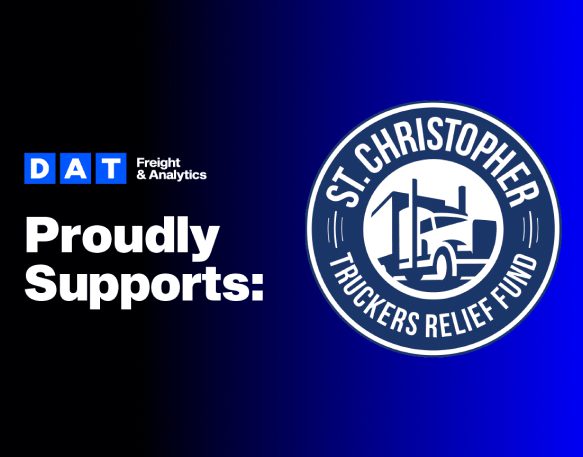The transportation and logistics sector is currently in flux amid ongoing reports of a potential UPS labor strike on the horizon. Negotiations between UPS and the Teamsters Union are expected to resume on Monday, with UPS reportedly ready to “sweeten their offer” in an effort to avoid a major work stoppage. In a recent poll DAT conducted with 74 shipper customers, the majority think the strike is still unlikely, but would have a slight-to-moderate impact on their operations. However, if both sides fail to come to an agreement by the August 1 deadline, a nationwide walkout of 340,000 UPS workers will likely ensue – marking the largest strike against a single employer in U.S. history that would undoubtedly affect the freight market.
UPS handles 20 million packages daily, equating to roughly a quarter of all parcel shipments in the United States. From large-scale CPG manufacturers and retailers to localized grocers and small businesses, delays could permeate every layer of the North American supply chain ecosystem. UPS pilots, albeit members of a separate union, also vowed not to cross the picket line should a strike occur, making high-value shipments for just-in-time delivery like manufacturing parts, pharmaceutical drugs, and medical devices nearly impossible.
Experts predict that the strike would first impact e-commerce deliveries, mirroring delays from the pandemic’s early stages. Among Amazon’s 8 billion deliveries in 2022, 60% (3.2 billion) were shipped through its logistics network of third-party carriers. UPS handled 8% of those parcels (256 million), further indicating that even only a few days of stoppage would result in millions of e-commerce shipment disruptions. The last UPS strike in 1997 lasted 15 days and cost the company $850 million. Fast forwarding 25 years, a 10-day strike in August is expected to cost the U.S. economy more than $7 billion, with $4 billion in losses for consumers and small businesses.
A looming spot market surge?
While the likelihood of a strike at this scale is still unclear, its residual effects could be significant for shippers and carriers alike — heightening the importance of ensuring their operations are prepared for disruption. Depending on how much progress is made when negotiations resume, many companies could begin to divert linehaul freight typically handled by UPS onto alternative transportation modes like FTL, LTL, intermodal and maritime. This would result in significantly reduced capacity across the truckload market and cause rapid upticks in spot rates.
In order to avoid costly supply chain bottlenecks and meet the needs of certain high-value verticals like healthcare and pharmaceuticals, shippers would drive intense competition for any additional capacity to move priority shipments. And with such high volumes of freight shifting in such a short period of time, spot market disruption would soon follow both from the initial surge and the subsequent dip that follows it.
“If it happens, there’s going to be a lot of long nights,” said DAT Chief of Analytics Ken Adamo in a recent FleetOwner article. “Switching costs will be high.”
The market has already been active following its typical summer slowdown. In the first full shipping week after the Fourth of July holiday, load posts outpaced truck posts on the DAT One network from July 10-16, creating slightly higher load-to-truck ratios for each of the major trailer types. It wasn’t enough to increase rates, however, with dry van and reefer averages falling while flatbed remained flat. As the UPS situation progresses, shippers should be keeping a close eye on how the van freight market evolves.
The importance of data-driven agility
The potential UPS strike is a microcosm of an overarching challenge faced by shippers every day: unpredictable spot market volatility. It underscores the criticality of leveraging external freight market intelligence to effectively navigate unexpected market fluctuations. Freight analytics provide a true pulse on the market with real-time rate visibility, indicating optimal times to either strategically leverage spot contracts for increased capacity or instead opt for traditional carriers.
This holistic view of the market enables more proactive decision-making during periods of high adversity, allowing shippers to benchmark performance against trusted datasets to avoid spot market exposure and build resilience along their supply chains.
- RateView Analytics: Generates visibility into past, present, and future spot and contract market rates for strategic sourcing, planning, and cost management.
- Network Analytics: Produces extensive lane and carrier insights that help mitigate routing guide failure, secure reliable capacity, and build resilience with a diversified portfolio.
- Analytics Services: Optimizes shipping operations with advanced data services, seamless integration support, and access to trained consultants with deep industry expertise.
With the right data and analytical tools, shipping leaders have the foresight they need to accurately assess if private and dedicated capacity is in the right places. In addition, they can also better identify high-risk areas within their transportation network and shift private or dedicated fleet capacity away from them before suffering irremediable losses. Compounded at scale, analyzing freight market data is the best way to maximize transportation spend and foster effective budgeting strategies in an unstable economic climate.
Regardless of how the UPS labor negotiations unfold, the unpredictable spot market is here to stay. It’s important for shippers to position themselves with the right data and resources to effectively plan for the road ahead. For more information on how DAT iQ’s solutions help shippers take the uncertainty out of freight, reach out to one of our experts today.


